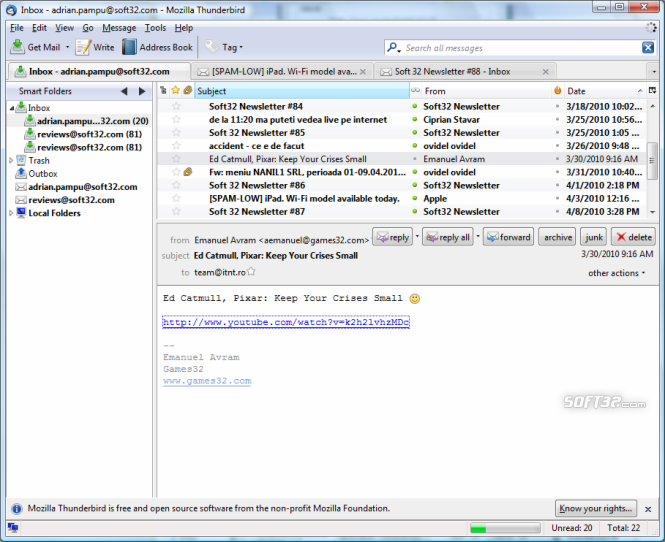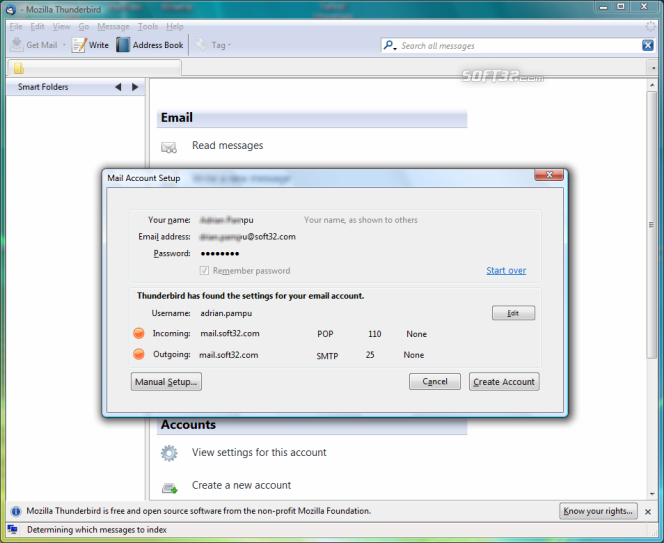The first is to offer more than Microsoft’s Outlook, the default choice for businesses that need to manage their email communications. And the second challenge is to offer more than Gmail, the default choice for individuals who need to manage their email communications.
Mozilla’s Thunderbird shows just how hard it is for any email client software to meet both those challenges. The service itself is more than adequate, and the volunteers who have built and grown the open source project have put serious thought into improving the user experience. Mail account setup, which has always been one of the biggest bugbears of switching clients, is now relatively simple. Instead of searching for IMAP, SMTP and SSL settings (and understanding what they are), Thunderbird now only asks for name, email address and password.
If you can just remember your password, you’ll be collecting your emails right away. Other aspects of Thunderbird match Mozilla’s overall look and feel. Mozilla’s Firefox browser was one of the first to introduce tabs, and that essential tool has been brought over to Thunderbird. Leave multiple emails open and you can switch between them as easily as you switch between tabs on your browser (and equally run the risk of hitting open tab overload.)
Like Gmail, Thunderbird scans your email before you send it and looks for words like “attachment” to remind you that you forget to attach your file, and the quick filter toolbar makes filtering a breeze. When you want to keep your inbox organized and shoot incoming mail directly into a folder, you’ll find setting up the parameters quick and easy.
Thunderbird has even teamed up with third-party providers to supply personalized email addresses. Just choose an address, such as firstname@lastname.com, and Thunderbird will set it all up. A host of add-ons and themes add a bunch of extra features, including calendars, encryption, and contact tools. For a free email client, Thunderbird certainly has a great deal to recommend it. But the popularity of the software has waned over the last few years. Although Mozilla has continued to roll out security updates and ideas from Firefox, Thunderbird has received no major update since 2012. In December 2015, Mitchell Baker, Mozilla’s executive chairwoman, said that the foundation would like to stop supporting the software altogether, arguing that its continued support drew resources away from projects, like Firefox, that have a greater impact on the industry. The long lag time that can strike users with heavy inboxes is something that’s unlikely to be fixed.
The reason for Thunderbird’s demise has nothing to do with its functions, which are all useful and well-designed. It has everything to do with the fact that the software is a desktop tool in a world that has now been mobile for some time. And while businesses still need a comprehensive and secure email client for their office work, that need is now largely met by enterprise software solutions that bundle in calendar and other functions.
Thunderbird does the job it was designed to do but many users will find themselves wondering whether that job hasn’t now been made obsolete.
Conclusion
Mozilla Thunderbird is a beautiful, well-made email client for a world that isn’t sure it needs email clients.
| Usability: 9 /10 | Speed: 8.5 /10 | Features: 9.5 /10 | Support: 8 /10 | Pricing: 10 /10 |






Usability
10
Speed
10
Features
9
Support
7
Pricing
10
Excellent product….more support for Thunderbird on this forum:
https://groups.io/g/ThunderbirdEmail
Thunderbird has been drastically updated since 2020-07. It now supports end to end encrypted messages, so your email service provider cannot harvest your into for profit.
see Thunderbird.net
Usability
6
Speed
6
Features
6
Support
3.2
Pricing
7.8
With it’s base in the old Eudora, It’s ok, especially compared to MS Outlook, but, disappointingly, no better than that, and has a host of really annoying features, e.g.:
* Help is hard to find and use – I’ve been trying forever to get the damn thing to default to personalized list of files on the left but have been unable to get it to do this consistently; similarly how to get it to default to a typeface and size of my choice and stay there
* The “Thunderbird thinks this is a fradulent email” (or whatever exactly the message says) is a total waste of time: I’ve had it come up hundreds of time without ever its ever once identifying a problem email, almost always normal messages I want to receive
* For reasons I haven’t figured out, it’s design is flawed in that it’s by far the worst program I’ve ever seen in terms of accidental deletions due to some keystroke inadvertently higlighting the message and the next deleting it – horrible, disastrous in this regard this regard, especially for the not so good typist who’s looking at the keys, not the screen, a lot of the time!
And so on – an only barely acceptable choice for the person who wants a non-webmail (POP or other desktop) program and has no time at all for the MS Mess. Too bad
/
Usability
8.3
Speed
9.1
Features
7.9
Support
5.9
Pricing
5.8
gbcg
Worked great until recently. Now I find my answered emails with 2 question marks at the end of each sentence. If the sentence is less than 3 words it has no question marks. I correspond with elderly people and this is beginning to cause confusion.
Usability
10
Speed
10
Features
10
Support
10
Pricing
10
Not one complaint. the best i have tried. Great platform. Does everything i need plus more.